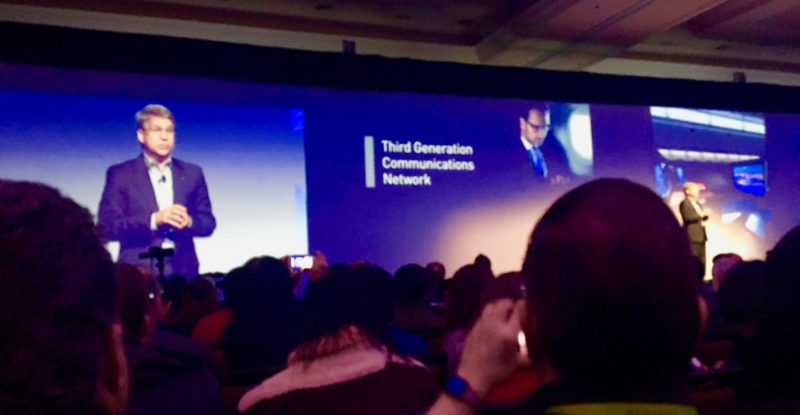Vastly improved data rates. Faster, more responsive Internet. Streaming video and, where permitted, VoIP and video-enabled chat. These are just some of the benefits that passengers can expect as Panasonic Avionics rolls out its third generation connectivity network for its airline clients, the IFEC giant vowed today at CES in Las Vegas.
As expected, a new Newtec-manufactured modem and high throughput satellite (HTS) service covering all dense mobility traffic areas – and boasting “virtually seamless beam switching” – form key parts of the third gen network. Together these will help to deliver data rates which are “20 times more” than now achieved, according to Panasonic Avionics senior director of corporate sales and marketing Jon Norris.
United Airlines and new Panasonic customer Southwest Airlines will be the first carriers to benefit from the boost during the first quarter of this year, said Panasonic North America chairman and CEO Tom Gebhardt during this morning’s media briefing about the range of Panasonic technology solutions which will be unveiled this week at CES.
United, in particular, should welcome the move, as the airline and its passengers have been vocal about their discontent with Panasonic’s current connectivity service.
Improved TV picture quality, a broader TV channel choice, and the capability to offer 3G phone services via Panasonic’s AeroMobile subsidiary – plus greater bandwidth for airline crew applications – are also being promised to airlines.
Panasonic has used #CES2018 to announce the launch of its third generation inflight connectivity offering, which will initially roll out on Southwest and United. It includes the previously reported Newtec modem, yes, but also a mega boost in Ku HTS capacity. #paxex #avgeek #iot pic.twitter.com/svBex2ICVc
— Runway Girl Network (@RunwayGirl) January 8, 2018
But behind the scenes Panasonic is also ramping up its customer support with the launch of a new Customer Performance Center (CPC), which combines the firm’s mission control center, network operations center and Air Ops team into a common organization.
The CPC will exploit traffic shaping tools, enable live monitoring and management of the user experience, and support Panasonic’s new real-time content loading, validation and management service called ZeroTouch.
The traffic shaping “is not a means to throttle back heavy consumers”, stressed Norris. Rather, it’s aimed at ensuring that passengers “have the experience they expect” including accessing “the types of applications they want to use”.
Panasonic’s vision for the CPC “is to be the industry leader for service and support with a focus on Customer Performance Expectations – facilitating, enabling and delivering our global services”.
Additionally, Panasonic will offer airlines new business intelligence tools and reports, arming them with data and analytics to deliver targeted pricing and advertising campaigns. Providing predictive analysis on upcoming trends in the connectivity market will “ensure optimal experience for customers”, said Norris.
To date, over 1,900 aircraft have been fitted with Panasonic’s Ku-band satellite connectivity service, and that number is expected to reach 2,000 this quarter.
https://twitter.com/RunwayGirl/status/950435538485391365
The inflight connectivity market is hotly competitive, and Panasonic faces competition from multiple suppliers including ViaSat, Gogo, Global Eagle, Inmarsat and Inmarsat’s Global Xpress value added resellers Thales and SITAONAIR. Thales is also rolling out a new Ka-band solution, with financial services firm William Blair reporting today that Air Canada, a Gogo customer, will launch the Thales service on its Boeing 737 MAX fleet. Air Canada’s first MAX, with an antenna radome, broke cover a few days ago on Twitter. The airline has not responded to a request for confirmation.
Looks like @AirCanada has a hump on their #737MAX ….not sure if there is anything under the hump and/or it works! #PaxEx pic.twitter.com/ci8qxQ3AYb
— born2flyjet (@born2flyjet) January 5, 2018
For its part, Panasonic expects that more than 10,000 aircraft will be connected with its connectivity by 2025. Its subsidiary, ITC Global, will leverage the new broadband network to deliver connectivity to its energy, maritime and enterprise customers.
Related Articles:
- Panasonic tackles QoS wifi issues with HTS capacity and new modem
- Panasonic partners with Newtec for high-speed modem
- As Southwest rolls out Panasonic Ku every tail counts for IFC providers
- Panasonic Avionics revises XTS satellite plan for aero connectivity
- Panasonic looks to transform content loading with Zero Touch











